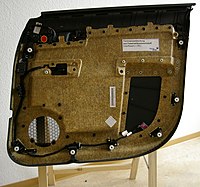
Photo from wikipedia
The development of biocomposite materials used as adsorbents to remove ions in aqueous media has become an attractive option. The biomasses (base materials) are chemically treated and impregnated with metal… Click to show full abstract
The development of biocomposite materials used as adsorbents to remove ions in aqueous media has become an attractive option. The biomasses (base materials) are chemically treated and impregnated with metal cations, becoming competitive for fluoride-capture capacity. In this research, Valence orange (Citrus sinensis) and Red Delicious apple (Malus Domestica) peels were modified by alkaline treatment, carboxylation, and impregnation with zirconium (Zr). These materials were characterized morphologically and structurally to understand the modifications in the treated biomasses and the mechanism of fluoride adsorption. The results show changes in surface area and composition, most notably, an increment in roughness and Zr impregnation of the bioadsorbents. After batch experimentation, the maximum capacity of the materials was determined to be 4.854 and 5.627 mg/g for the orange and apple peel bioadsorbent, respectively, at pH 3.5. The experimental data fitted the Langmuir model, suggesting that chemisorption occurs in monolayers. Finally, the characterization of the bioadsorbents in contact with fluoride allowed the replacement of OH species by fluoride or the formation of hydrogen bonds between them as an adsorption mechanism. Therefore, these bioadsorbents are considered viable and can be studied in a continuous system.
Journal Title: Polymers
Year Published: 2022
Link to full text (if available)
Share on Social Media: Sign Up to like & get
recommendations!